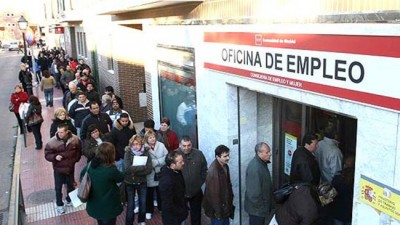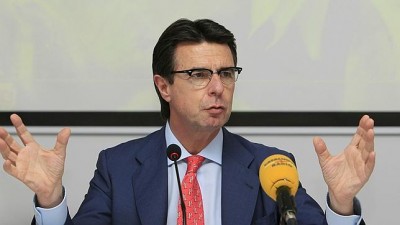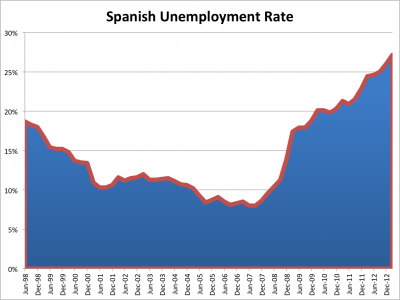
****
Spain has been held up by the gullible and naïve (some might say, cynical and malign) hard-green-left as the model for our “new” energy future. Some “model”!!
The Spaniards have thrown 100s of billions of euros in subsidies at solar and wind power, and have achieved nothing but economic punishment in return.
The power generated is delivered at chaotic, random intervals: the sun sets every day and the wind stops blowing, just like everywhere else in the world; requiring 100% of wind and solar capacity to be matched by fossil fuel generation sources.
As a result, in the last decade, the true cost of power has spiralled out of control. However, the Spanish government used price caps in an effort to keep prices artificially low. But that simply left taxpayers with an even greater burden to cover the massive cost of renewables subsidies (which represent a state-mandated transfer from the poorest to the richest) – add mounting government debt used to keep the subsidy stream flowing – and it can be fairly said that Spain’s energy policy is nothing short of an economic disaster.
The much touted promise of thousands of so-called “green” jobs never materialized. No surprises there. Instead, the insane cost of subsidising wind and solar power has killed productive industries, with the general unemployment rate rocketing from 8% to 26% (and still rising) – youth unemployment is nearer to 50% in many regions.
The Spanish government is faced with a choice between salvaging what’s left of a moribund (and shrinking) economy and keeping the renewables gravy train rolling.
Here are two reports on Spain’s belated efforts to bring its renewable energy disaster to a close.
Spain close to approving new renewable energy rules: minister
Reuters
29 May 2014
MADRID (Reuters) – The Spanish cabinet could approve on Friday a law that will cut renewable energy subsidies as part of a drive to reduce a 30 billion euro ($41 billion) power tariff deficit, built up during years of keeping prices below regulated costs.
The new law, the thrust of which was announced by the government in July last year, set the rate of return for existing renewable energy facilities at 7.4 percent and at 7.5 percent for future operations.
Many renewable energy companies have made double-digit returns on investment under hefty subsidies. Spain has passed a series of measures over the past two years cutting, and in some cases eliminating, renewable energy subsidies and a number of investors have filed international legal complaints.
“(The decree) is ready to go,” Industry Minister Jose Manuel Soria told reporters on Thursday, adding that the decision to approve it at Friday’s weekly cabinet meeting would be taken later on Thursday.
The minister acknowledged the reform was bad news for companies that invested expecting higher returns.
According to documents annexed to the reform, to which Reuters had access last week, the government plans to cut renewable energy subsidies by 15 percent this year to 7.63 billion euros.
The new rules will be retroactive to July 2013 and many companies have already made massive provisions and writedowns in their 2013 financial results, anticipating the impact of the decree.
The regulation includes variations for a range of technologies – including wind, thermosolar, photovoltaic and biomass – and the year the assets were installed.
For example, assets installed before 2005 will receive no subsidy and will only be awarded with the wholesale power price, while newer assets will receive the wholesale price plus a separate remuneration.
(Reporting by Jose Elias Rodriguez, writing by Tracy Rucinski; editing by Julien Toyer and Keiron Henderson)
Reuters

****
Spanish Lesson For Obama: Green Energy Transition Unaffordable, May Soon Crash
Die Welt
Ute Müller
31 May 2014
Lawsuits may force Spain to bring its renewable energy experiment to an end, a green policy fiasco that has gone terribly wrong due to astronomical costs. It’s a powerful lesson for the White House that has often cited the Spanish model as one to emulate.
Only recently, Spain was widely praised as the champion of wind energy in Europe. What is more, all over the country new solar parks were built and renewable energy had become the main source of energy supply on the Iberian Peninsula. Those days, however, may soon be over. That’s because Spain’s industry ministry intends to drastically cut back on subsidies for “clean energy.” The whole country has to cut back, the industry ministry argues drily, and energy producers have to do too.
This argument seems irrefutable since the figures that are now assessed by the government are astronomical indeed. The subsidies that are going to flow into green energy projects on the Iberian Peninsula amount to a staggering 200 billion euros. Approximately 56 billion euros have already been paid out. The lion’s share of this sum went into rather generous feed-in tariffs for wind and solar energy which, since 1995, have attracted numerous investors from both home and abroad.
The remaining 143 billion euros are due to be paid out in the next 20 years for green energy projects that have already been connected to the grid, foremost for solar farms.
Given these sums, it would appear that industry minister Jose Manuel Soria has come to the conclusion that the only option left is to put his foot down. He now plans to cut green subsidies for the energy sector by about 20 percent, to 7.5 billion euros per annum. The minister, however, has not reckoned with affected green investors who are up in arms and fighting the planned subsidy cuts.
Moratorium on new solar farms
This is not the first time that Spain intends to take advantage of solar investors retrospectively. Numerous foreign investment funds, especially from the US, have invested heavily in Spain’s renewable energy in recent years, expanding solar energy production significantly. They were lured by promises by the then socialist industry minister who had agreed a fixed rate of return of 14 percent per annum for solar park investments.
“The sun can be yours,” huge billboards claimed. Thousands of Spanish investors were keen not to miss this golden opportunity either. As a result, solar power production on the sun-drenched Iberian Peninsula increased from 53 to 313 gigawatt hours (GWh) between 2007 and 2010.
Surprised by the huge demand, the government of socialist Prime Minister José Luis Rodríguez Zapatero introduced a moratorium for new solar farms, guaranteed feed-in tariff were reduced to 25 years and the premiums were paid only for a certain number of hours of sunshine per year. After a change of government at the end of 2012, the new conservative administration upped the ante and introduced a new electricity tax of 7.5 percent, causing the profits for the solar industry to fall by around 30 percent.
A good opportunity for nuclear power?
This week, U.S. energy company Nextera Energy has summoned Spain before the International Centre for Settlement for Investment Disputes (ICSID) to demand redress. The U.S. company regards the new rules as a retroactive change to the original guarantees. Nextera Energy has invested heavily in the Spanish solar power plant Termosol.
Other large investors, such as a Deutsche Bank investment fund, involved in the Andalusian power plant Andasol, and French bank BNP have asked ICSID, a World Bank organization, for arbitration. Another group of foreign investors issued first lawsuits in 2011, based on the European Energy Charter which promises investment protection and prohibits expropriation.
If the investors win their case, Spain can expect claims for damages amounting to billions of euros. In such a case, the further expansion of renewable energy in Spain would then come to end end at once. The industry minister is not the only one who is aware of the potential consequences. Two traditional power generators, Endesa and Iberdrola, even see a good chance for new deals with nuclear power. They have requested an extension of the operating license for the Garoña nuclear power plant which had already been taken off the grid. Garoña is now expected to provide electricity until 2031. The investors believe that despite new security investments the nuclear power plant will be profitable. They expect that after the boom and bust of recent years the share of renewable energy will decline.
Die Welt (translation by Global Warming Policy Foundation)
Spain provides the perfect “model” for any Country looking to destroy itself in blind pursuit of “green” energy ideology.
Trying to power a (notionally) first world economy with intermittent and unreliable wind and solar power is nothing more than an infantile delusion. When the cost of the insanity is borne by millions of struggling (and probably unemployed) power consumers and 100s of thousands thrown on the unemployment scrap heap, it borders on the criminal.
Spaniards can only hope that their political betters’ efforts to unwind the mess haven’t come too late.



Here’s a working link for “innovative” schemes in the comment above above.
Spain’s green energy subsidies have sparked some “innovative” schemes to enable the bandidos to get their snouts into the “free” subsidy money trough. At one point this apparently included subsidies paid for solar electricity generated during the hours of darkness. They wouldn’t, would they:
Reblogged this on Cornwall Wind Watch.